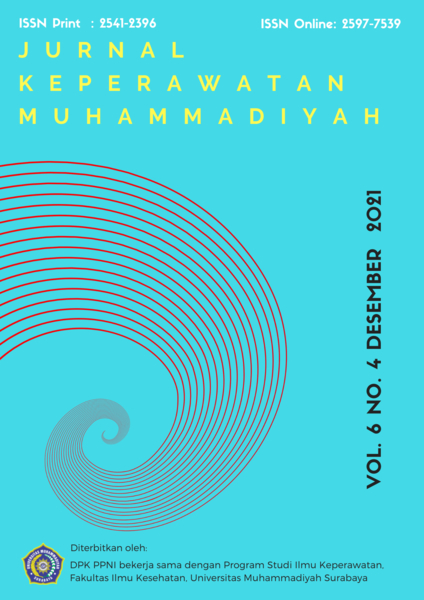Faktor Prediktor Kepatuhan Clinical Pathways COVID-19 di Rumah Sakit
DOI:
https://doi.org/10.30651/jkm.v6i4.11828Keywords:
Clinical Pathways, Nurse, COVID-19Abstract
Objective: Clinical pathways for covid-19 are the best efforts made by nurses in handling cases of covid-19. However, there are still nurses who have not been optimal in implementing COVID-19 clinical pathways. For this reason, this study aims to analyze predictor factors for compliance with Covid-19 clinical pathways in hospitals, Surabaya, Indonesia during the COVID-19 pandemic.Methods: This study used a cross sectional study, with a sample size of 126 nurses selected from a private hospital in Surabaya. Data was collected using the Covid-19 clinical pathways measurement scale instrument and sociodemographic questionnaire, used to obtain information about the characteristics of respondents.
Results: The results of statistical analysis with regression test showed p = 0.000, that the predictor factor of clinical pathways adherence was the role of nurses, with a value (OR 379,479, 95% CI 41,391, 3479,165), this shows the role of nurses with good categories will have an impact on high compliance in clinical pathways covid-19, while the factors of age, gender, educational background, and length of work are not predictor factors in the compliance of clinical pathways covid-19 in hospitals
Conclusion: Nurses in carrying out their roles well have an impact on Covid-19 clinical pathways compliance, and it is proven that nurses' roles are strong predictors in determining clinical pathways compliance in hospitals. Therefore, the capacity building program and the development of nurse resources are important to be given in order to continue to apply the covid-19 clinical pathways.
References
Aradista, A. M. (2020). Hubungan Antara Health Belief Model dengan Perilaku Kepatuhan Kebijakan Pembatasan Sosial Berskala Besar (PSBB) Selama Pandemi COVID-19 pada Emerging Adult. SUKMA: Jurnal Penelitian Psikologi, 1(2), 117-130.
El Baz, N., Middel, B., Van Dijk, J. P., Oosterhof, A., Boonstra, P. W., & Reijneveld, S. A. (2007). Are the outcomes of clinical pathways evidence-based? A critical appraisal of clinical pathway evaluation research. Journal of evaluation in clinical practice, 13(6), 920-929. doi:https://doi.org/10.1111/j.1365-2753.2006.00774.x
Evans-Lacko, S., Jarrett, M., McCrone, P., & Thornicroft, G. (2010). Facilitators and barriers to implementing clinical care pathways. BMC health services research, 10(1), 182. doi:10.1186/1472-6963-10-182
Fauzia, N. (2015). Pengaruh faktor individu, organisasi dan perilaku terhadap kepatuhan perawat dalam melaksanakan hand hygiene di ruang rawat inap rumah sakit tk. ii dr. soepraoen malang. Jurnal Aplikasi Manajemen, 12(4), 731-739.
Folami, F., Olowe, A., & Olugbade, J. (2019). Factors affecting the use of nursing process in Lagos University Teaching Hospital, Lagos, Nigeria. International Journal of Africa Nursing Sciences, 10, 26-30. doi:https://doi.org/10.1016/j.ijans.2018.12.001
Gray, K., Dorney, P., Hoffman, L., & Crawford, A. (2021). Nurses' pandemic lives: A mixed-methods study of experiences during COVID-19. Applied Nursing Research, 60, 151437. doi:https://doi.org/10.1016/j.apnr.2021.151437
Green, L. W., & Johnson, J. L. J. C. j. o. p. h. R. c. d. s. p. (1996). Dissemination and utilization of health promotion and disease prevention knowledge: theory, research and experience. Canadian journal of public health, 87, S11-17.
Green, L. W., Ottoson, J. M., Garcia, C., & Hiatt, R. A. (2009). Diffusion theory and knowledge dissemination, utilization, and integration in public health. Annu Rev Public Health, 30, 151-174. doi:10.1146/annurev.publhealth.031308.100049
Ilmah, F., & Rochmah, T. N. (2015). Kepatuhan pasien rawat inap diet diabetes mellitus berdasarkan teori kepatuhan niven. Jurnal Administrasi Kesehatan Indonesia, 3(1), 60-69.
Lin, F.-r., Chou, S.-c., Pan, S.-m., & Chen, Y.-m. (2001). Mining time dependency patterns in clinical pathways. International journal of medical informatics, 62(1), 11-25. doi:https://doi.org/10.1016/S1386-5056(01)00126-5
Lwanga, S. K., & Lemeshow, S. (1991). Sample size determination in health studies: a practical manual: World Health Organization.
Pratama, B. S., Koeswo, M., & Rokhmad, K. (2015). Faktor determinan kepatuhan pelaksanaan hand hygiene pada perawat IGD RSUD dr. Iskak Tulungagung. Jurnal Kedokteran Brawijaya, 28(2), 195-199.
Sadli, A. (2021). Rancangan Pengembangan Aplikasi Dokumentasi Clinical Pathway Berbasis Web. Jurnal Manajemen Sistem Informasi dan Teknologi, 11(2), 157-166.
Santoso, E., Siswanto, V., Umilia, E., Syafitri, R., & Desiana, T. (2021). Modeling the effectiveness of the PSBB based on COVID-19 case in Greater Surabaya Area. Paper presented at the IOP Conference Series: Earth and Environmental Science.
Syuhada, K., Wibisono, A., Hakim, A., & Addini, F. (2021). Covid-19 risk data during lockdown-like policy in Indonesia. Data in Brief, 35, 106801. doi:https://doi.org/10.1016/j.dib.2021.106801
Xu, G., Yang, Y., Du, Y., Peng, F., Hu, P., Wang, R., . . . Chang, C. (2020). Clinical Pathway for Early Diagnosis of COVID-19: Updates from Experience to Evidence-Based Practice. Clinical Reviews in Allergy & Immunology, 59(1), 89-100. doi:10.1007/s12016-020-08792-8
Downloads
Published
Issue
Section
License
- Penulis tetap memegang hak atas karyanya dan memberikan hak publikasi pertama kepada jurnal ini yang secara simultan karya tersebut dilisensikan di bawah:Â Creative Commons Attribution-ShareAlike 4.0 International (CC BY-SA 4.0)













